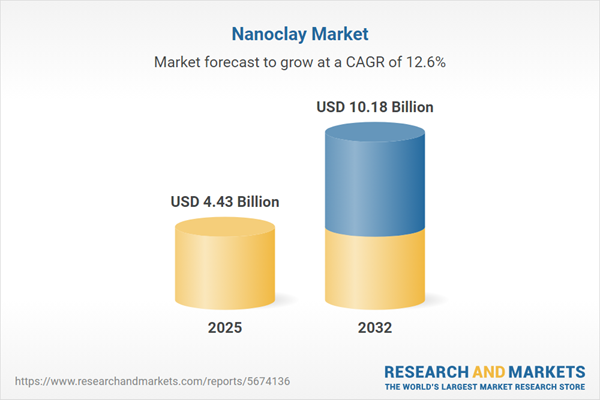Speak directly to the analyst to clarify any post sales queries you may have.
Nanoclay is redefining the advanced materials landscape, presenting new avenues for performance-driven innovation in industries from automotive to electronics. This market research report delivers actionable insights for senior decision-makers looking to capitalize on shifts in demand, regulatory trends, and evolving manufacturing priorities within the nanoclay market.
Market Snapshot: Nanoclay Market at a Critical Growth Phase
The nanoclay market continues its upward trajectory, expanding swiftly amid surging cross-industry requirements and heightened regulatory attention. Steady gains are propelled by the material’s ability to deliver mechanical strength, thermal resistance, and barrier properties to composite matrices. The period ahead presents significant opportunities for manufacturers and suppliers, with notable momentum across consumer goods, industrial applications, and infrastructure investments. Industry participants are adapting to changing supply dynamics and new standards, reinforcing nanoclay’s reputation as a key enabler for sustainable and high-performance products.
Scope & Segmentation of the Nanoclay Market
- Applications: Automotive exterior and interior components, under-the-hood applications, concrete additives, insulation materials, EMI shielding, electrical insulation, thermal management, cosmetic and pharmaceutical packaging, food and beverage packaging, as well as diverse paint and coatings formulations.
- Types: Halloysite, kaolinite, montmorillonite, and organoclays, including both ammonium-based and phosphonium-based subtypes.
- End-User Industries: Automotive (OEM and aftermarket), construction (commercial, infrastructure, residential), consumer and industrial electronics, food and beverage (bottled, dairy, packaged), and pharmaceuticals (drug delivery carriers, packaging).
- Regions: North America (United States, Canada, Mexico), Latin America (Brazil, Argentina, Chile, Colombia, Peru), Europe (including United Kingdom, Germany, France, Russia, Italy, Spain, Netherlands, Sweden, Poland, Switzerland), Middle East (UAE, Saudi Arabia, Qatar, Turkey, Israel), Africa (South Africa, Nigeria, Egypt, Kenya), and Asia-Pacific markets (China, India, Japan, Australia, South Korea, Indonesia, Thailand, Malaysia, Singapore, Taiwan).
- Leading Companies: Market coverage includes Imerys S.A., ALTANA AG, Clariant AG, Adeka Corporation, BASF SE, Minerals Technologies Inc., UBE Industries, Ashapura Minechem Limited, Zhejiang Fenghong Group, and Gujarat Mineral Development Corporation.
Key Takeaways for Decision-Makers
- Nanoclay’s versatility fuels its adoption across polymers, coatings, and composites, providing vital improvements in performance and processability for diverse applications such as automotive lightweighting and advanced packaging.
- Innovation in surface functionalization enhances compatibility with hydrophobic matrices, enabling manufacturers to tailor solutions for premium, sustainable, and specialty-market requirements.
- As end-user sectors shift to prioritize regulatory compliance and environmental impact, suppliers benefit from investing in green processing methods and bio-based nanoclay variants.
- Strategic collaboration and partnerships, including alliances with research entities and end-user industries, are facilitating faster commercialization and differentiation in product offerings.
- Supply chain adaptation in response to geopolitical tensions and tariff fluctuations is prompting companies to explore localized production and diversified sourcing models.
- Emerging applications are opening up further opportunities in medical devices, renewable energy components, and high-performance electronics, expanding the addressable market.
Tariff Impact: Navigating New Trade Barriers
The recent imposition of United States tariffs on selected nanoclay products has resulted in notable shifts along global supply chains. Upstream suppliers in Asia face increased costs, which in turn is influencing purchase strategies, contract terms, and regional production relocations among international manufacturers. These changes are driving both short-term cost pressures and long-term investments in supply chain resilience, including the development of near-shore processing facilities to mitigate risk exposure.
Methodology & Data Sources
This analysis uses a comprehensive research framework, integrating primary interviews with nanoclay producers, industry experts, and end-users, along with extensive reviews of peer-reviewed literature, patents, and regulatory filings. Quantitative and qualitative insights are triangulated using established models to provide an unbiased, transparent assessment of market developments and drivers.
Why This Report Matters
- Enables data-driven decision-making with rigorous segmentation and risk analysis across the nanoclay market value chain.
- Supports strategic planning by clarifying competitive positioning, investment priorities, and new application domains.
- Equips stakeholders to anticipate emerging trade dynamics, regulatory trends, and supply chain vulnerabilities within their operational sphere.
Conclusion: Strategic Imperatives for Sustained Advantage
Effective navigation of the nanoclay market requires adaptability to evolving regulatory and trade dynamics, continued technology investment, and strong collaborative networks. This report guides industry leaders toward opportunities that support competitiveness and innovation across sectors.
Additional Product Information:
- Purchase of this report includes 1 year online access with quarterly updates.
- This report can be updated on request. Please contact our Customer Experience team using the Ask a Question widget on our website.
Table of Contents
3. Executive Summary
4. Market Overview
7. Cumulative Impact of Artificial Intelligence 2025
List of Figures
Samples

LOADING...
Companies Mentioned
The key companies profiled in this Nanoclay market report include:- Imerys S.A.
- ALTANA AG
- Clariant AG
- Adeka Corporation
- BASF SE
- Minerals Technologies Inc.
- UBE Industries, Ltd.
- Ashapura Minechem Limited
- Zhejiang Fenghong Group Co., Ltd.
- Gujarat Mineral Development Corporation Limited
Table Information
| Report Attribute | Details |
|---|---|
| No. of Pages | 196 |
| Published | October 2025 |
| Forecast Period | 2025 - 2032 |
| Estimated Market Value ( USD | $ 4.43 Billion |
| Forecasted Market Value ( USD | $ 10.18 Billion |
| Compound Annual Growth Rate | 12.6% |
| Regions Covered | Global |
| No. of Companies Mentioned | 11 |









